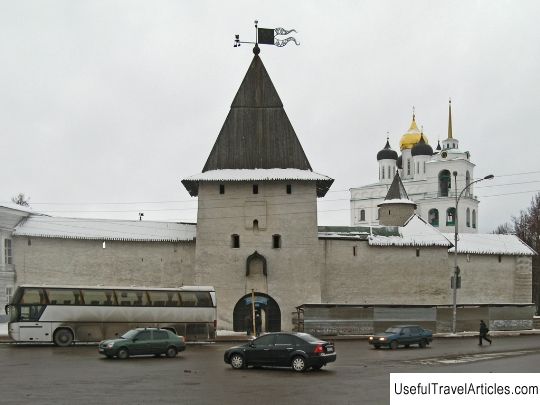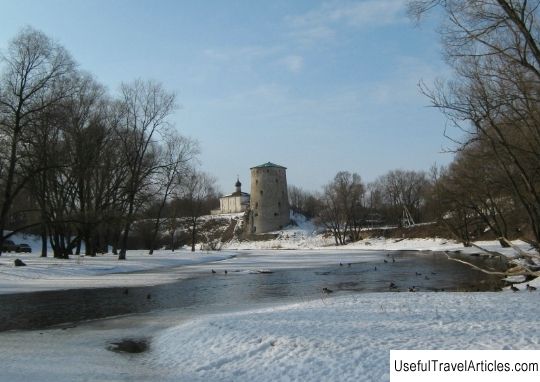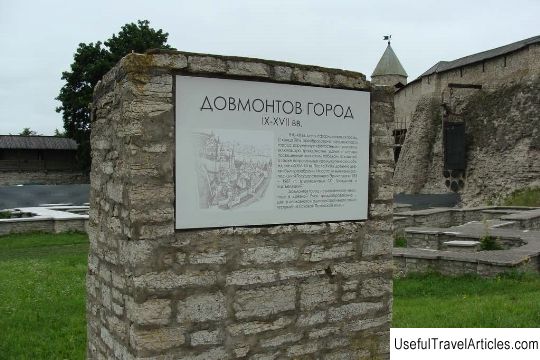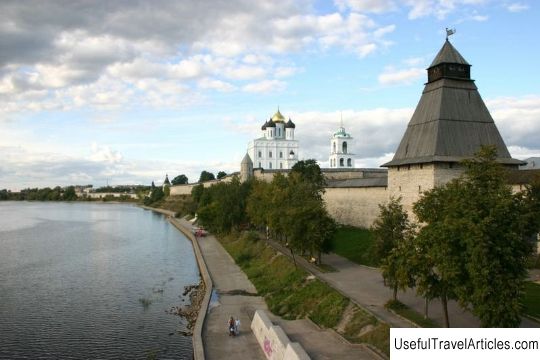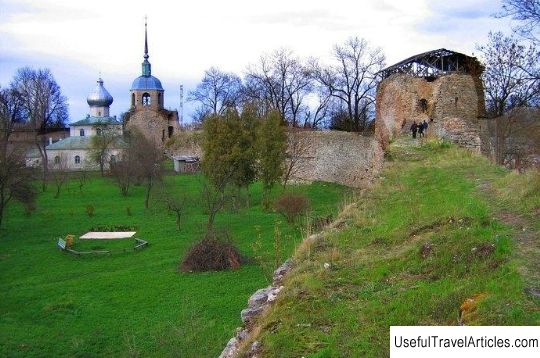Pskov Kremlin description and photos - Russia - North-West: Pskov
Rating: 8,7/10 (1930 votes) 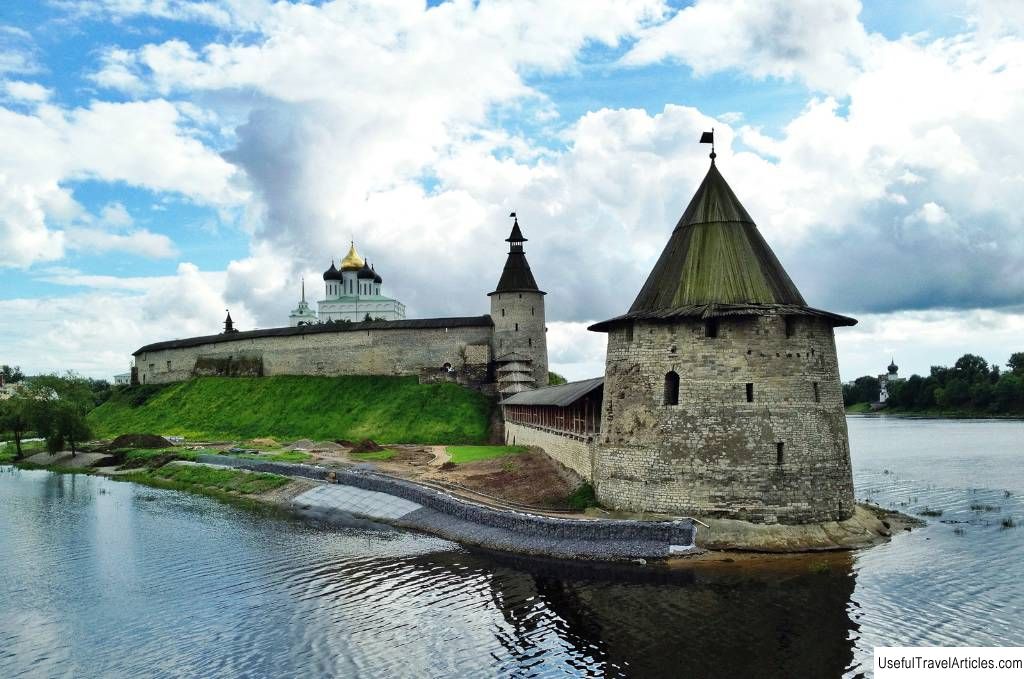
Pskov Kremlin description and photos - Russia - North-West: Pskov. Detailed information about the attraction. Description, photos and a map showing the nearest significant objects. Photo and descriptionPskov was the largest Russian western fortress, a free city, which time after time successfully repelled the attacks of enemies. Quite a lot of its city fortifications remained - the ensemble of the Krom and Dovmont cities and the remains of the outer line of the walls on the other bank of the Pskova River. All together, including the high and visible St. Sophia Cathedral, makes up a picturesque and interesting ensemble. History of the Pskov fortressAn ancient settlement with earth fortifications at the confluence of two rivers - Pskova and Velikaya, existed since VIII century, and already from the X century there were stone walls. The current fortifications date back to the XIV century. Pskov, constantly forced to repel the onslaught of the invaders, was the most powerful western Russian outpost. Since the XIII century, the territory of the Kremlin began to be divided into Krom and Dovmont city, fortified and surrounded by a new wall with towers, a section of the posad, which soon became the administrative center. It is called so by the name of the holy prince Dovmont (Timothy), who ruled the city at the very end of the 13th century. There were merchant churches, which simultaneously served as warehouses for goods: at the moment, 17 church foundations have been opened on the territory of Dovmont town. In the XIV-XV centuries. Pskov became a free city ruled by a popular veche, not a prince. It was fortified by a triple row of walls, the outermost of which reaches almost seven kilometers. In 1659, Pskov was stormed by the Polish-Lithuanian troops for five months and so they could not take it. In 1615, the city was besieged by the Swedes - and again they failed to capture it. By the beginning of the Northern War, there were 40 towers on which more than 200 cannons and arquebuses stood. The fortress lost its strategic importance after the Great Northern War. In the 17th-19th centuries, the outer walls were gradually destroyed and dismantled. By the middle of the 20th century, most of the fortifications are literally in ruins - they were saved by the Soviet restoration of the middle of the century. Some of the towers were completely recreated - some in the form in which they were conceived, some - taking into account the reconstructions of the 17th century. However, restoration work on various parts of the walls and towers continues to this day: the structures were damaged during a fire in 2010 and a hurricane in 2015. Walls and towers Until now, seven towers and several sections of walls have come down from the first line of fortifications. This is, first of all, "percy" - the front wall of Crom, at the most dangerous section by the river, and the zhab protecting the gate. Throughout the history of the city, the "Percy" was renovated and repaired almost constantly, because the wall was washed away and destroyed by the river. The maximum height of the Pskov walls is 8 meters. An interesting tower with the unusual name of Kutekroma. The word "kute" means a corner - this is the corner tower of the Krom-Kremlin. Its height is 30 meters, it served as a watchtower. This tower was completely destroyed during the rebuilding of the fortress for the Northern War, and was rebuilt by restorers in 1961. The Rybninskaya tower over the Holy Gates leading to the Dovmont town was also completely restored. But the gate tower of Vlasyevskaya has been preserved since the 15th century practically unchanged, only the wooden top has been restored. The city customs office was located here. The passage through the tower was once rather narrow and protected by a special fortification - a zhab, so now the gates that could be used to get to the Kremlin by transport had to be cut in the wall next to it. The curtain connects the Kremlin with the Flat Tower - the most squat of all, standing on the very shore. It is the view of it from the river that is the "calling card" of Pskov in photographs and souvenirs. The section of the curtain leading to the tower is open to the public. In addition to the Kremlin itself, there is also the remainder of the remaining lines of fortifications on the other side of the river. First of all, it is the colorful High or Voskresenskaya tower - just opposite the Ploskaya. These two towers defended the mouth of the Pskova: a wall was built between them across the river with a gate through which ships sailed, and which were closed during the war. The second wall of the same kind, across the river, passed between the not preserved Nikolskaya and the preserved Gremyachya tower. Preserved Mikhailovskaya, Pokrovskaya and Varlamovskaya towers - they constituted the fifth line of fortifications and defended the Okolny city. Trinity Cathedral According to legend, the first Trinity Church was built here by the order of the legendary princess Olga. A relic called "Holguin's Cross" is preserved here. Tradition says that this is the very cross that the princess once erected on the site of the future temple. It was renovated after a fire at the beginning of the 18th century, and was last restored from 2014 to 2018. The wooden church erected under Olga was replaced by a stone one, and the cathedral received its present appearance in 1699, when it was rebuilt after a great fire. It stands on an old foundation. The new cathedral is taller than the previous one - its height is 78 meters. This is a very elongated upward, far visible, four-domed building with five heads, built under the influence of Moscow architecture. The oldest part of the building has been preserved - the princely and bishop's tomb in the basement. Now the remains of all those buried are collected in one silver shrine, it is revered as a shrine. Here are not only the relics of the holy princes, but the famous Pskov holy fool Nikola, who once saved the city from ruin by Ivan the Terrible, is buried here. The carved iconostasis was created at the beginning of the 18th century. At the same time, the temple icon of the Trinity, which is considered miraculous, was written. Once it was in front of this temple that there was a veche square of Pskov, where all the most important city affairs were resolved. The legendary sword of Saint Dovmont was kept here, which was solemnly presented to all the Pskov princes. Subsequently, it was in this cathedral that the royal manifestos were read - for example, the manifesto on the abolition of serfdom. Together with the new cathedral, a bell tower appeared - one of the fortress towers was rebuilt for it, building it first in wood and then in brick ... A clock was installed on it, which ran for more than a hundred years, and only in 1885 was it replaced with a new one, made in Germany. After the revolution, the cathedral became renovated for some time, and then closed and transferred to the museum. It was reopened during the German occupation, however, retreating, the Germans mined it and it was badly damaged. After the war, the cathedral was restored under the leadership of the famous Pskov historian and restorer Y. Spegalsky and was no longer closed. Of the modern sights that have appeared in it, the painting of the chapel of St. Seraphim of Sarov, made by the famous icon painter Zenon. Once there was another cathedral in the Kremlin - the warm Annunciation built in the 18th century. It was demolished during the Soviet years, and now in its place stands an imposing memorial cross on a stone foundation. Order Chamber and Museum In the Dovmont town there is the only preserved stone civil building of the late 18th century in Pskov - the order chamber. This is the main administrative building of the city, where the court, money, ambassadorial and other "tables" were located, that is, in fact - the departments that governed Pskov. In the basement there was a prison, and on the upper floor there were the governor's chambers. Since the 18th century, the building was transferred to the spiritual consistory, and then it was used for shops and a tavern, famous throughout Pskov. In the 1960s, it was returned to its original appearance and transferred to the museum. Now there is a museum exposition telling about the administration of the city in the 17th century, and the interior of that time is reproduced in two chambers: the governor's chamber and the clerk's chamber. In the clerk's ward, the tables and their functions are described. And in the chambers of the voivode there is an exhibition dedicated to the famous Pskov voivode of the times of Alexei Mikhailovich - Afanasy Ordin-Nashchokin. In addition, temporary exhibitions of the museum are held in this building. Interesting facts
Note
                  We also recommend reading Bari Cathedral (Cattedrale di Bari) description and photos - Italy: Bari Topic: Pskov Kremlin description and photos - Russia - North-West: Pskov. |


